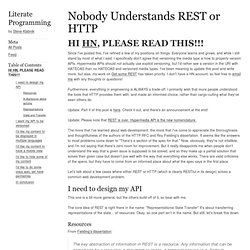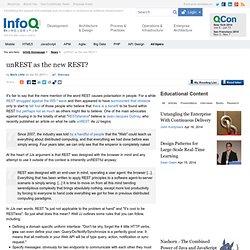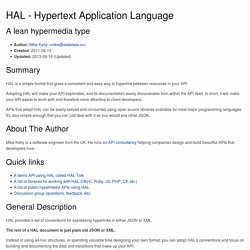

Ten Reasons Developers Hate Your API. Writing Usable APIs in Practice. Jackson JSON Processor - Home. The Right End of REST. One of our Licensed ZapThink Architects, Michael Poulin, struggled with our recent ZapFlash, Where is the SOA in REST-Based SOA?

In a forum post, Poulin asked: Using Atmosphere for comet, websocket and REST Web Services. What is Comet?

Comet is technique to refresh the web browser from server push without refreshing the page. Comet is known by several other names, Ajax PushReverse AjaxTwo-way-webHTTP StreamingHTTP serv See the following very good presentation on Comet and WebSocket understanding. Nobody Understands REST or HTTP. Since I've posted this, I've refined a few of my positions on things.

Everyone learns and grows, and while I still stand by most of what I said, I specifically don't agree that versioning the media type is how to properly version APIs. Hypermedia APIs should not actually use explicit versioning, but I'd rather see a version in the URI with HATEOAS than no HATEOAS and versioned media types. I've been meaning to update this post and write more, but alas, my work on Get some REST has taken priority.
I don't have a HN account, so feel free to email me with any thoughts or questions! Furthermore, everything in engineering is ALWAYS a trade-off. Update: Part II of this post is here. Update: Please note that REST is over. Two Voices — Stereoplex. API design for integrating SAAS services - ChargeBee. Developer Think Tank - Blog. Uberblic. SXSW 2012: The Year of the API. Is this the year of the API?

Or is it next year? As we’ve pointed out before, the API universe is expanding. You have a chance now to make sure when thousands of geeks descend upon Austin next March, that this new way of the web is given the billing it deserves. But you have to get moving by September 2. There were over 3,000 potential talks submitted and public votes have a big say in what makes its to the SXSW stages.
ProgrammableWeb does have a vested interest in your votes, of course. There’s a lot more to The Year of the API than ProgrammableWeb, of course. We found these by searching for API, APIs and companies/individuals we thought might be speaking about APIs. Both comments and pings are currently closed. Classification of HTTP APIs. This table provides a classification of HTTP-based APIs.

The classification achieves an explicit differentiation between the various kinds of uses of HTTP and provides a foundation to analyse and describe the system properties induced. Microformats vs RDFa vs Microdata « Philip Jägenstedt. Warning: The microdata syntax has changed (e.g. item="foo" is now itemscope itemtype="foo") since this blog post was written.

Don’t copy the examples. I spent last weekend with my good friend Emil sketching a REST-style interface for his graph database Neo4j. One of the output formats we wanted was plain HTML for easy debugging via the browser. UnREST as the new REST? It's fair to say that the mere mention of the word REST causes polarisation in people.

For a while REST struggled against the WS-* wave and then appeared to have surmounted that obstacle only to start to fall foul of those people who believe that there is a benefit to be found within REST but perhaps not as much as others might like to believe. One of the main advocates against buying in to the totality of what "RESTafarians" believe is Jean-Jacques Dubray, who recently published an article on what he calls unREST.
As JJ begins: Since 2007, the industry was told by a handful of people that the "Web" could teach us everything about distributed computing, and that everything we had done before was simply wrong. Four years later, we can only see that the emperor is completely naked. Amundsen. I've been spending the last several months experimenting w/ a repeatable methodology for expressing business processes as media types for dist-net implementations (aka "the Web"). this blog post is one of a series i've been doing over the last year or so as i attempt to improve upon these patterns and practices. the RESTBucks example the book REST in Practice uses a very effective demonstration app called RESTBucks to illustrate the authors' ideas on how to build RESTful solutions. the book is one of three (along with RESTful Web Services and The RESTful Web Services Cookbook) i highly recommend for those interested in applying the REST style. i like the 'RiP' book for a number of reasons. one of them is that the problem domain used for the example (RESTbucks) is both simple enough to grasp and complex enough to be non-trivial.

IMO, this makes for a great teaching tool when discussing REST, Hypermedia, and dist-net architectures. HAL - Hypertext Application Language. A lean hypermedia type Author: Mike Kelly <mike@stateless.co>Created: 2011-06-13Updated: 2013-09-18 (Updated) Summary HAL is a simple format that gives a consistent and easy way to hyperlink between resources in your API.

Adopting HAL will make your API explorable, and its documentation easily discoverable from within the API itself. In short, it will make your API easier to work with and therefore more attractive to client developers. APIs that adopt HAL can be easily served and consumed using open source libraries available for most major programming languages. About The Author.